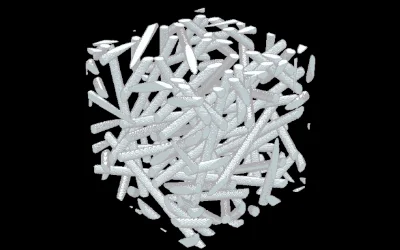For the chemical vapor infiltration of pyrolytic carbon the ratio of surface area to free volume plays a crucial role in understanding and modeling the deposition process. Here, the evolution of surface area and free volume during the infiltration of fiber felts was calculated quantitatively. For parallel fibers in a square or hexagonal 2D lattice the evolution was calculated analytically using simple geometrical considerations. For this case one local minimum in the ratio of surface area to free volume vs. radius of the fibers was found. For overlapping fibers the evolution was approximated using a Boolean model. For this model, the ratio of surface area to free volume was obtained analytically for fibers with any degree of orientation anisotropy. We find that the ratio of surface area to free volume increases linearly with the radius of the fibers. The model also allows to estimate surface area, free volume and surface area / free volume ratio for felts with non-overlapping fibers for low initial filling factors. Finally, models of felts with randomly distributed, non-overlapping fibers with different degrees of orientation anisotropy, including parallel fibers and isotropic orientation of the fibers, were generated. Based on these models the evolution of surface area and free volume were calculated numerically. The surface area / free volume ratio increases nearly linearly for all initial filling factors and for all degrees of orientation anisotropy up to a filling factor of 95 %. Our data allow the calculation of the evolution of A/V for typical infiltration experiments based only on the knowledge of the fiber felt parameters
Calculation of the evolution of surface area and free volume during the infiltration of fiber felts
